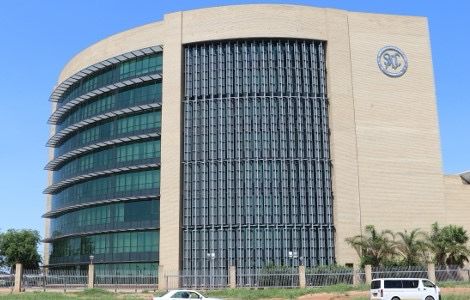SOLAR power is more expensive than the electricity supplied by Erongo Red, contrary to what the Swakopmund municipality advocates, the regional power distributor says.
E-Red CEO Gerhard Coeln was reacting to the municipality saying that providing solar power to low-cost housing projects would be the cheaper option. Besides, Coeln told The Namibian, the municipality was “not licensed to engage in the provision of electricity”, as it had transferred all its electrical functions to Erongo Red when the company was established.Coeln said the municipalities in the region had agreed that they would not provide any electricity-related service for as long as E-Red held a licence for the distribution and supply of electricity.”The point is, we’ve been appointed for electricity distribution and supply, and if there are projects that need to be serviced, we, with the guidance of and to the specifications/requirements of the Electricity Control Board, try and find the most viable options,” he said.”This includes the electricity services proposed for the Swakopmund low-cost housing projects.”Swakopmund last year started looking into cheaper alternatives of providing electricity to low-cost housing developments.The Town Council said the solar option would be the cheapest, since no power lines would have to be installed.It calculated that equipping the houses with solar power would cost half the price of connecting them to the power grid.According to information presented during the last council meeting of 2007, basic solar kits – consisting of a solar panel, battery, light switches and wall sockets – would cost about N$10 000 per house.It said it would cost about N$21 000 per erf to connect new housing developments to the power grid run by E-Red – not including any electrical installation in the house itself.But Coeln said one had to compare apples with apples – a grid connection would offer residents between 20 and 60 Ampere of electricity at 230 Volts.The N$10 000 solar installation, on the other hand, would only generate enough power for “four lamps”.”No cooking, fridges or DStv decoder – maybe enough for a black-and-white TV and cellphone charger,” he said.”One must ask if this is what these families that opt for low-cost housing want, because it’s not just one person that will live in these houses.Many people rent out space in the house or shacks for additional revenue to pay for the N$9 000 house and municipal services, and then the solar system will not be able to carry the electrical load.”He said a solar-power system offering the equivalent of what Erongo Red offers would cost a lot more than N$10 000.”A 250-Watt system, which provides 1 Amp of electricity [at 230 Volts] would cost N$30 000, according to prices collected from the market by NAMREP.Erongo Red offers a fully integrated system, with a minimum of 20 Amps – which is 20 times more power – for N$21 000,” he said.Coeln said he was not against solar power, but it was not yet the right option for low-cost urban housing projects.He said these solar units would need to be upgraded as families and needs grew, and be maintained by the house owner.”Who will do this – and how much extra would this cost both the municipality and the resident?” Coeln asked.Besides, Coeln told The Namibian, the municipality was “not licensed to engage in the provision of electricity”, as it had transferred all its electrical functions to Erongo Red when the company was established.Coeln said the municipalities in the region had agreed that they would not provide any electricity-related service for as long as E-Red held a licence for the distribution and supply of electricity.”The point is, we’ve been appointed for electricity distribution and supply, and if there are projects that need to be serviced, we, with the guidance of and to the specifications/requirements of the Electricity Control Board, try and find the most viable options,” he said.”This includes the electricity services proposed for the Swakopmund low-cost housing projects.”Swakopmund last year started looking into cheaper alternatives of providing electricity to low-cost housing developments.The Town Council said the solar option would be the cheapest, since no power lines would have to be installed.It calculated that equipping the houses with solar power would cost half the price of connecting them to the power grid.According to information presented during the last council meeting of 2007, basic solar kits – consisting of a solar panel, battery, light switches and wall sockets – would cost about N$10 000 per house.It said it would cost about N$21 000 per erf to connect new housing developments to the power grid run by E-Red – not including any electrical installation in the house itself.But Coeln said one had to compare apples with apples – a grid connection would offer residents between 20 and 60 Ampere of electricity at 230 Volts.The N$10 000 solar installation, on the other hand, would only generate enough power for “four lamps”.”No cooking, fridges or DStv decoder – maybe enough for a black-and-white TV and cellphone charger,” he said.”One must ask if this is what these families that opt for low-cost housing want, because it’s not just one person that will live in these houses.Many people rent out space in the house or shacks for additional revenue to pay for the N$9 000 house and municipal services, and then the solar system will not be able to carry the electrical load.”He said a solar-power system offering the equivalent of what Erongo Red offers would cost a lot more than N$10 000.”A 250-Watt system, which provides 1 Amp of electricity [at 230 Volts] would cost N$30 000, according to prices collected from the market by NAMREP.Erongo Red offers a fully integrated system, with a minimum of 20 Amps – which is 20 times more power – for N$21 000,” he said.Coeln said he was not against solar power, but it was not yet the right option for low-cost urban housing projects.He said these solar units would need to be upgraded as families and needs grew, and be maintained by the house owner.”Who will do this – and how much extra would this cost both the municipality and the resident?” Coeln asked.
Stay informed with The Namibian – your source for credible journalism. Get in-depth reporting and opinions for
only N$85 a month. Invest in journalism, invest in democracy –
Subscribe Now!










